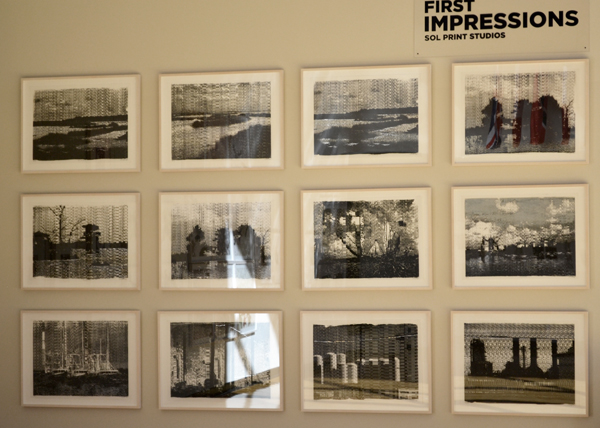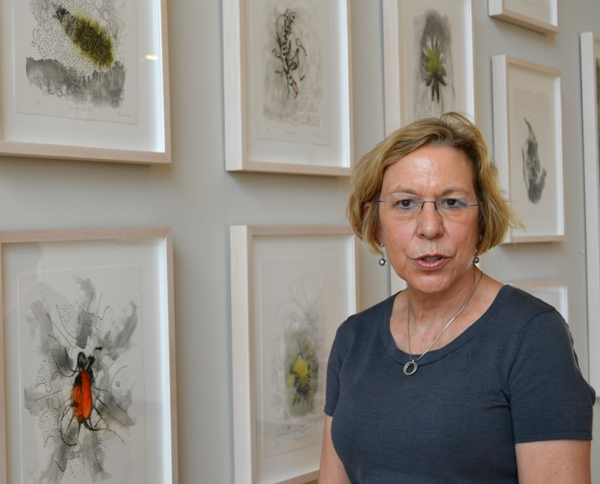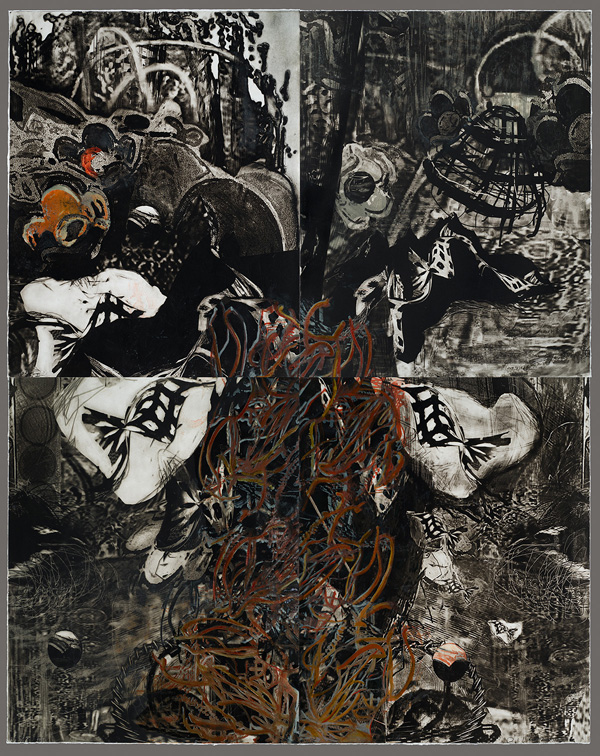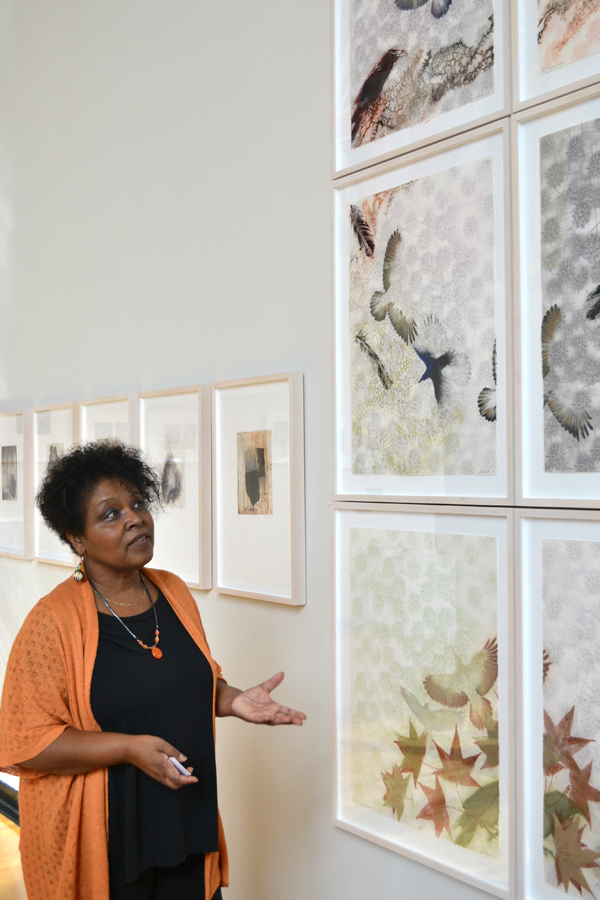Sol Print Studios Exhibition at Stevenson University
Printmakers and print collectors alike should make a pilgrimage to Stevenson University, just north of Baltimore, to view First Impressions, Sol Print Studio, an exhibition on view in the St. Paul Companies Pavilion until Nov. 30, 2012. Better yet try to attend the discussion by Soledad Salemé, Sol Print Studio’s founder, on Nov. 13 at 4 p.m.
The work of Salemé and the 12 other artists are all the product of the solarprint method, a nontoxic way of producing intagio plates via solar etching. Soledad was introduced to this method by Dan Weldon in the late 1990s when he hosted a workshop at Goya Contemporary in Hampden. After working at Weldon’s Long Island studio and subsequently consulting with him, she decided to open her own solarprint studio in Baltimore in 2009. All the prints shown were produced under Salemé’s mentoring at Sol Print Studio.
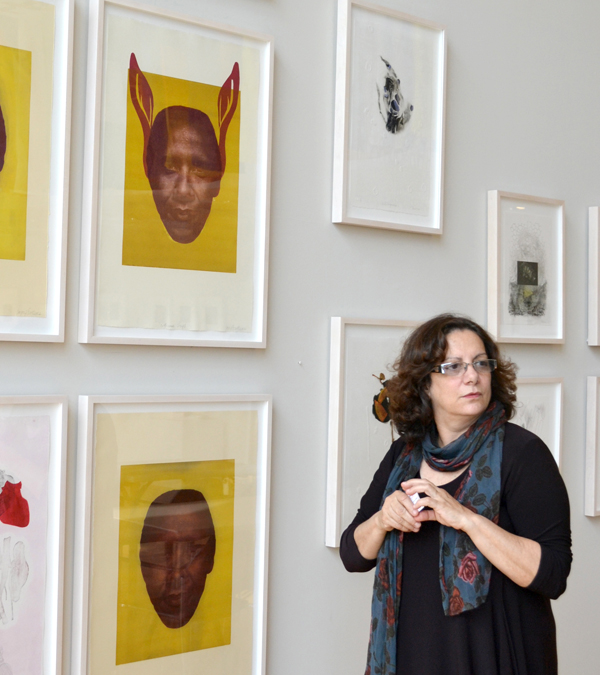 < Soledad Salemé discusses the prints of Joyce C. Scott, the Eleven Obama Series of 2012. Some of Christine Neill’s botanically inspired works are behind her.
< Soledad Salemé discusses the prints of Joyce C. Scott, the Eleven Obama Series of 2012. Some of Christine Neill’s botanically inspired works are behind her.
Invariably the artwork involved the use of multiple plates, sometimes with digital printing used for the first or background image. This is not your traditional printmaking. But some of the images have the immediacy of the best traditional prints. I should state, at this time, my perspective on viewing this work. My eyes are trained as a collector of American prints c.1920-50 for over 30 years. Almost all of these are black and white and therefore required only one pass through the press. So looking and appreciating the Sol Print impressions require me to look at this work with fresh eyes.
In fact when I first viewed the work, I didn’t have the vocabulary to describe them. So I phoned Salemé and asked her to guide me through the exhibition. Not only did she agree to do so, but, when we met recently, she brought some of her fellow printmakers with her. I got a chance to talk one-on-one with these artists and hear the how’s and why’s behind their images. Later they each graciously answered some questions I put to them via email. Here are their responses:
This is the installion of Salemé’s Gulf Distorions I-XII at Stevension. But when I asked her for an unframed image of this work, this (below) was the arrangement. Each tier makes more sense this way. As you see she worked with four groups of three: wetlands, areas of trees, shrimp trawlers, and oil drilling works. The Baltimore Museum of Art has purchased a set of these prints.
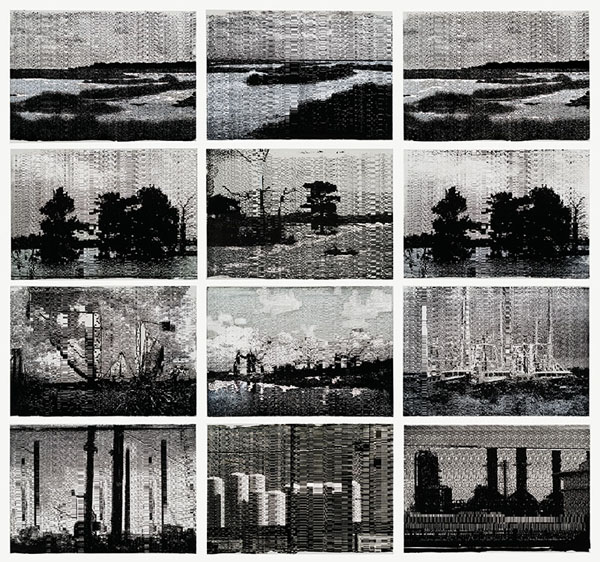
SOLEDAD SALEME
How did the exhibtion at Stevenson come about?
Diane DiSalvo [Stevenson’s gallery director] had previously worked with me and became interested in the works coming out of the workshops. She heard from artists in the community about the work that was being developed here and offered to jury an exhibition for Stevenson. I had seen the exhibition Print By Print, which was a collaboration between Rena Hoisington, Curator of Prints, Drawings & Photographs at the BMA, and the students of Johns Hopkins University and Maryland Institute College of Art. It was this exhibit that inspired me to propose that each artist develop a series of prints.
And what does it mean to you and to Sol Print Studio to see all these prints exhibited together?
Having introduced many of the artists to the basics of solar etching, mono print and encaustic, it has been thrilling to see the development over time through different series of workshops. Working together I have really seen great strides in their individual growth not only as printmakers but also as artists. I am very proud to see the growth and quality of the work that was produced in Sol Print Studio. This is the only etching studio available to artists in Baltimore, except for the universities.
Seeing the work come together in this show points out the ambition of this project and the quality of the work that was accomplished by the artists in such a short time.
When I asked her specifically about the genesis of Gulf Distortions, she gave me a detailed project statement. So I’m going to parse it.
Enormously upsetting, the Deepwater Horizon oil spill disaster and its global repercussions led me to develop the Gulf Distortions project. I drove to Louisiana after the oil spill, during the initial clean-up efforts. The military and the police kept us from getting close to the contamination. Still, we managed to capture images of the marshes, floods, the remains of the local shrimping industry, and the oil drilling equipment that litters the coastline.
To visualize my sense of environmental fracture and displacement, I manipulated the photographs that documented our encounter with this disaster, submitting the images to an intensely fraught facsimile process. I worked with the staff at the St. Francis Community Center near my studio to simulate a cyber traffic jam, sending a number of photographic images by digital fax to the Center’s fax number all at the same time. The effect was to overwhelm the Center’s analogue fax machine, causing the output of highly pixilated images. For me, the combination of old and new technology holds metaphoric weight. The fax machine distorts the images in the same way that the human hand disturbs and distorts nature.
For Gulf Distortions, I-XII (2010-2011), I chose 12 images that represent my sense of the estrangement between nature and humans. I transferred the images from digital to analogue, altering and abstracting their composition through the antiquated technology of the fax machine. I screen printed the reiterated images onto frosted Mylar and detailed the oil spill by printing on silver paper with interference pigments.
The damaged topography of the Gulf region is reflected in the resulting fragmented still life scenes. On another level, these formalist views of disaster speak to the rupture of our relationship with the world just outside our window.
CHRISTINE NEILL
Could you describe how your work as a watercolorist and as amateur botanist influenced the work you did with Sol Print Studio? (Full disclosure, I took a Continuing Studies watercolor class with Neill at MICA in the 1970s.)
I deliberately took the first workshop to help myself understand some work that I wanted to do … and wasn’t having success with–large watercolors combing prints of cellar structures of plant forms.
By working on small-size prints in an experimental way, I gained skills that are transferable to the group of mixed-media watercolors. The process of layering the etchings with other media helped me to concurrently work through the difficulties I was encountering in the watercolor pieces that are over five feet high and layered with complex and expensive digital prints. After the workshops I proceeded with the mixed-media watercolors with new insights and experimental fervor.
Can you briefly relate the steps involved and the discoveries made in producing the prints shown at Stevenson?
Developing a process for assembling the images prior to printing was as labor intensive and valuable an experience as applying the etching techniques. I had wanted to combine drawings of cell structures of plants with images of plants for some time. Through Soledad’s guidance, I ultimately combined a cell drawing and a wash drawing in Photoshop and printed them as one image onto Rives BFK, developing a different combination for each print. Simultaneously, I prepared a scan or photograph of a plant form and had a solar etching plate made from it.
During the first workshop I printed three copies of seven plates, adding color, a la poupee, while inking the plate. Having seen the first prints, I decided I wanted to try working at a larger size and to prepare embossing plates to enhance the images.
During the second workshop, I printed six more images and embossed ten prints to complete the portfolio of thirteen images.
Decisions I hadn’t anticipated and discovered during the printing process included adding of color by working directly onto the plates and the idea of embossing suggested by the combination of images. I hadn’t done much work with embossing, and the physicality of making the embossing plates out of PVC was totally new. I used big drills, routers and a Dremel hot Exacto knife, which worked great.
During the second workshop I also realized that I wanted prints larger having seen some printed at a smaller scale, and I cut the solar plates into irregular organic shapes, rather than leaving them as rectangles. The decision to print Magnolia Split and La Playa Palm at a larger size and have the cell structures digitally printed on the inside of the framing Plexiglas was also a decision I hadn’t anticipated when I started the workshops.
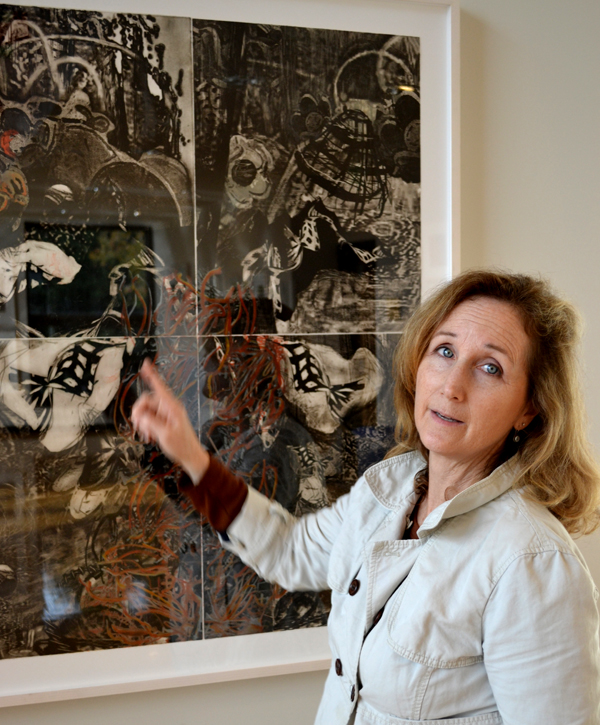
RANDI REISS-McCORMACK
Can you tell me about your work at Stevenson?
In the Stevenson Exhibition, I am exhibiting one of eight of an artist’s proof edition consisting of a four-plate print. In actuality, seven different plates were involved in the execution of this print along with the use of chine collé. Some of the plates are double exposed allowing an aquatint effect with a strong range of gray areas, while other plates are relief and rolled with ink rather than printed as intaglio. The work is part of a series based on x-rayed luggage and fantastical landscape images derived from daily life and common objects. I rework the images in digital processes from actual drawings and collage, ink wash and computer scans.
< Randi Reiss-McCormack, Relentless I, II, II, IV, 2012
In solar etching much of the process of printmaking that is done on the plate in traditional etching has to be considered in the development of the plate. So the manipulation of the different plates and plate development becomes very important.
In general, I approach all my work with the eye of a printmaker working in layers of paint, collage and mixed media. Printmaking has such range and versatility that it brings another level of exploration to one’s conceptual and mark-making considerations. This process provokes change and challenges. One has to pay attention to the dynamic results of a print and work within the process.
Working with Soledad in the studio is a wonderful experience as she keeps you focused on what you are trying to accomplish and finding the best way to execute your print works. The support and dedication she devotes to all of the artists that come to the studio is incredible. The collaboration of working in a studio with other artists is completely invigorating and energizing to one’s own art practices. So much time as an artist is spent alone in your own mind and studio. Therefore, sharing of ideas, techniques, and conversation (and of course lunch) is fantastic.
Oletha DeVane, Call to Freedom, 2012
OLETHA DeVANE
Could you tell me the story behind your work?
I’m inspired by the book, Bound for the Promise Land, by Kate Clifford Larson. The prints incorporate images of ravens which symbolize an oracle and are considered intelligent, courageous, leader amongst birds. I used them to represent Harriet Tubman. The seedpods of the sweet gum tree are the background element, and the trees are common in the forests of the Eastern Shore of Maryland where Tubman was born. Larson explains the seeds as “large, round, and covered with spiny, burrs. They littered the forest floor, sometimes inches deep, nature’s bed of nails.” Those seedpods–once the medicine with aromatic, therapeutic fragrance to the slaves; once healing folk treatment for wounds and dysentery; once the hollowed out trunk that served as a baby’s cradle–would then “pierce the calloused, unprotected feet of terrified runaway slaves, then the sweet gum tree would be among the first obstacles on the road to freedom.” I had read this story and was struck by the duality of nature. I’ve used the image of the sweet gum ball in other works.
As someone who is passionate about stories/history, I seek ways to define my work in whatever medium best tells the story. Over the years I’ve create works in video, painting, printmaking and sculpture, using diverse materials with the intent of developing more contemplative work. I’ve relied on historical, mythological and personal identity as a source of content. At Sol Print Studio, printmaking became a vehicle that allowed me to bring all those sensibilities together with Soledad’s expertise in printmaking. She provided a sensitive, well-structured, creative environment for artist to experiment and have their voice. The experience has been inspirational, and I can’t remember when I felt as good about a process.
Could you describe the steps behind the production of your dynamic piece?
The nine prints of Call to Freedom were created to be a single (60″ x 90″) wall piece produced at Sol Print Studio in Baltimore. Solar etching plates, embossing and cut-out plates were layered over the background motif of sweet gum balls. The background prints were generated from a photograph that I took and then reproduced on a laserjet printer using Rives BFK and different colored archival inks.
With the encouragement of Joyce [Scott] and Soledad, I’ve done prints at Sol Print Studio several times over the past five years and each time I’ve explored a different aspect using the solar plate. I’ve used the solar plates with encaustic, screenprint and digitally generated images. My first attempt at Call to Freedom was a series of screenprinted images of the sweet gum balls, but it was a failure. I went to a laser printer for the background images of the sweet gum ball because they were more defined and I wanted the viewer to recognize what they were. I imagined the placement of the raven(s) in the spiral formation and used different solar plates and solar plate cutouts for the final print. A hot-glue plate simulating barbed wire, and the printed leaves were inked separately.
Trackback URL: https://www.scottponemone.com/sol-print-studios-exhibition-at-stevenson-university/trackback/

